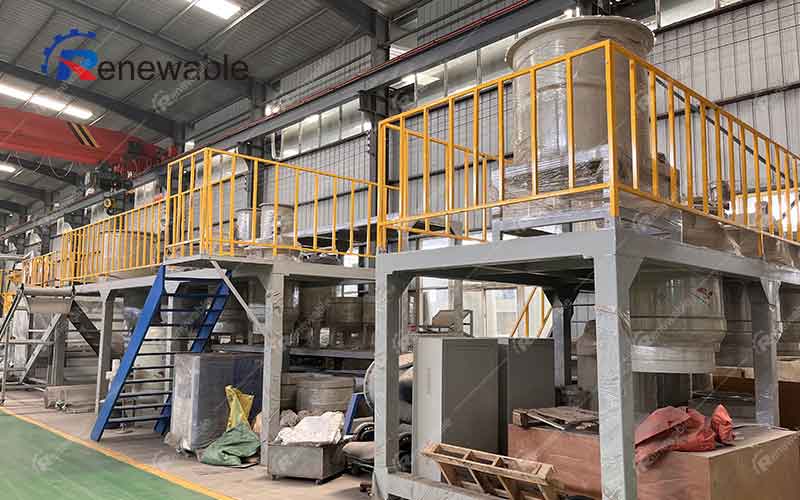1. Physical treatment technology
Physical treatment technology, also known as mechanical treatment technology, is a long-standing method for recovering metals from electronic waste. It mainly relies on the differences in physical properties between materials, such as density, conductivity, magnetism, etc., and enriches valuable substances through steps such as disassembly, crushing, and sorting. Although physical treatment technology has the advantages of low cost and low pollution, the recovery of precious metals still faces challenges because the content of precious metals in printed circuit boards is extremely low. Therefore, precious metal products obtained by various physical treatment technologies often require further processing. Currently commonly used physical recovery methods include impact crushing, extrusion crushing, shear crushing, high-speed eddy current crushing, etc.

2. Heat treatment technology
Heat treatment technology, a method of separating and extracting precious metals through high-temperature processes, has attracted much attention in recent years. It uses the changes in the physical and chemical properties of precious metals at high temperatures, such as melting point and vapor pressure, to enrich and extract precious metals through processes such as heating, smelting, and distillation. Although heat treatment technology has a high recovery efficiency, it also faces challenges such as high energy consumption and difficulty in pollution control. At present, commonly used heat treatment technologies include incineration, pyrolysis, smelting and zone smelting.
3. Pyrometallurgical treatment technology
Pyrometallurgical treatment technology, also known as incineration technology, is a process widely used in the early recycling of precious metals from electronic waste. Its core process is to use high temperature to oxidize organic matter and some metals in waste circuit boards so that they escape with gas, thereby achieving separation and purification. This technology covers a variety of methods such as incineration melting, high-temperature oxidation smelting, slag treatment and arc furnace sintering. Although pyrometallurgical technology is simple and convenient with a high recovery rate, its significant problems include: the production of a large amount of hydrogen halide, dioxin, furan waste gas and waste slag, and serious secondary pollution. Therefore, this type of method has gradually withdrawn from the mainstream vision.
4. Pyrolysis treatment technology
Pyrolysis treatment technology is completely different from pyrometallurgical treatment technology. It involves high-temperature heating and decomposition of organic matter in an oxygen-free or oxygen-deficient environment. In this process, organic matter is converted into gas, liquid (oil) and solid (coke) forms, thereby separating it from metals. This technology helps to recover metal-rich bodies. The Institute of Plasma Physics of the Chinese Academy of Sciences has successfully developed a plasma high-temperature pyrolysis device, which can efficiently decompose electronic waste into three types of substances: gas, glass and metal, and achieve effective separation through a 150kW high-efficiency arc under high-temperature plasma and oxygen-free conditions.
5. Hydrometallurgical treatment technology
Hydrometallurgical treatment technology is an important method in the recycling of printed circuit boards. It uses the solubility of precious metals and other common metals in strong oxidizing media such as nitric acid and aqua regia to allow these metals to enter the liquid phase from electronic waste for recycling. The advantages of wet treatment technology are that it has less waste gas emissions, can obtain high-grade and high-recovery precious metals and other non-ferrous metals, and is relatively inexpensive. However, it also has some disadvantages, such as wastewater treatment problems and the influence of the exposure of precious metals in raw materials on the leaching effect.
6. Biological treatment technology
The application of biological treatment technology in the recycling of electronic waste has also attracted much attention. This technology uses the metabolic activities of microorganisms to transform or degrade harmful substances in waste, thereby achieving the purpose of environmental protection and resource recovery. Neil et al. used Vibrio desulfuricans to recover gold and palladium from waste circuit boards. The experimental results showed that the recovery rate of palladium was as high as 95%. Although biological treatment technology is still in the laboratory stage, it indicates the development direction of new technologies in the future and is worthy of further research and exploration.
In the field of precious metal recycling of printed circuit boards, various treatment technologies have their own advantages. With the increasing number of scrapped electronic products, metal recycling in electronic waste has become increasingly important. Therefore, it is particularly urgent to develop efficient and environmentally friendly PCB precious metal recycling and treatment technologies. my country started late in this field and there is still a certain gap compared with developed countries. The government should increase its support for the research and development of electronic waste treatment and precious metal recycling technology, promote cooperation between enterprises, universities and research institutes, and form a virtuous cycle of research and development → industrialization → re-research and development. At the same time, in view of the complexity and diversity of printed circuit boards, a variety of technical means should be used in combination to optimize the combination to achieve the best economic and social benefits.